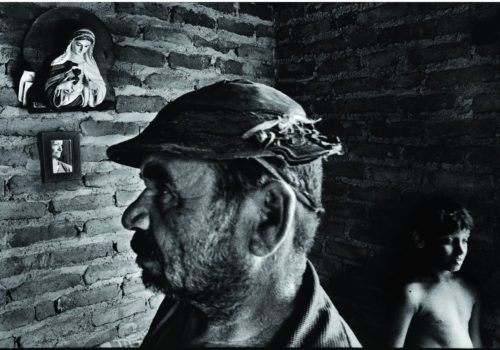Hopelessly dry soil, sad men and animals, pointless and endless waiting: this is Sertao, northern Brazil, a forgotten region lost in this economically and socially burgeoning nation. These incredible black and white pictures taken by Tiago Santana, also born in Nordeste, tell the story of this land and its men. Pictures that evoke Glauber Rocha’s cinematic vision Le dieu noir et le diable blond, Carlos Diegues’ Vidas secas and Los Olvidados by Luis Bunuel during his Mexican period. The downtrodden whose lives increasingly mirror this arid land, slowly dying of thirst. The pictures reveal rigid faces, emaciated dogs and donkeys staring blankly below the religious icons hanging on dilapidated walls. Misery playing out its tragic comedy.
But the photographer’s work is more than just documentary: exposing reality. He creates scenes, guides his subjects, composes artwork. Aesthetically charged, meticulously framed pictures bearing surrealistic audacity. The picture can, in a wide-angle shot, capture a face in the foreground, a glance, a hand. Or “zoom in” on a lost element in the background, eliminating the foreground. Photographed in this way, this little world, waiting now and forever for the grace of God (that of man has long been forgotten) transformed into charcoal drawn biblical frescoes. Work we would love to see in large format prints.
This marvelous little book published in the Actes Sud Photopoche collection, allows readers to discover Tiago Santana’s work, nearly unknown here yet a star in his country and throughout Latin America, and recently, in China. The excellent introduction by the great writer Eduardo Manet is also noteworthy.
Paul Alessandrini
Sertao
Pictures by Tiago Santana
Photo poche société
Actes Sud
















